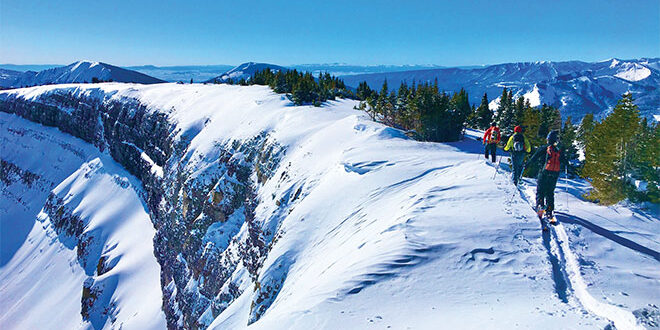“We don’t want to lose any more friends to avalanches”
[ by Than Acuff ]
Twelve years ago, while ski guiding in Italy, Jeff Banks and others were caught in an avalanche and Banks was swept 1,500 feet over cliff bands and through trees.
“We survived unscathed but that was just luck,” says Banks. “I’ve had the privilege of the best avalanche training, mentorship, exams, and experience available in our country, and it wasn’t good enough. That avalanche 12 years ago was the real genesis of this project. I thought to myself, we gotta do better.”
Banks lives in Crested Butte and has been in the avalanche industry for 18 years as an avalanche forecaster, an educator and has spent 16 years as an IFMGA certified mountain guide. That desire to “do better” took time to germinate. Now, after spending the past two years on development including 4,000 people hours, 80-plus hours of interviews and an immeasurable amount of additional research and input, Banks and partner JB Leach are on the cusp of releasing their new app called AspectAvy, developed to help people manage avalanche risk in the backcountry.
“We’re under no illusions that this is perfect, and it’s going to evolve over time, but we know it can bring massive harm reduction,” says Banks.
The idea for the app took its first big step in February of 2020 when Banks was teaching an avalanche course in Gothic, Colorado. It was a particularly tricky set of conditions and Banks could see the students were struggling with organizing their thoughts regarding the current conditions, not to mention the numerous other steps that go into planning a day in the mountains.
“They were just getting fire-hosed with all of this information,” says Banks. “I said, I can’t believe there isn’t an app to help with this.”
That comment by Banks at the hut caught the attention of Leach, who was a student in the course. Leach works as a product designer developing products for Fortune 100 and 500 companies and has focused his efforts on making complex systems and experiences more intuitive and inclusive.
“He said to me, ‘I can do that,’” says Banks.
Banks and Leach pulled from a variety of sources including reading studies done by Nobel Laureate economists, NASA scientists, used models developed regarding the application of avalanche data into decision making in Europe and hit the pavement for one-on-one interviews with backcountry users from the top of the avalanche education and guiding world to individuals just dipping their toes into winter backcountry recreation. It also helped that, thanks to the advent of Lidar (light detection and ranging), much of the mountain west has been mapped far more precisely than ever before, down to sections as small as two meters by two meters.
“We couldn’t have done this three years ago because we didn’t have Lidar mapping,” says Banks.
They took all of that, and more, developed their initial algorithm and put the first iteration of their app to the test last year both in the field and using thorough and consistent avalanche data available in Colorado and nationwide.
“We looked at avalanche fatalities in Colorado over the past 10 years and in the U.S. the past seven years because that was the furthest that consistent data we could use went back, and we determined that our app could have prevented 100% of those fatalities,” says Banks.
Banks refers to the “secret sauce” of the app as having three main ingredients. The first part is the algorithm they’ve developed that takes the information from the avalanche bulletin and overlays it on the map and the terrain to show the route for a low-risk tour.
“Low risk is similar to driving, 1 in 100,000 chance,” explains Banks. “High risk is a 1 in 100 chance, similar to base-jumping or free climbing with Alex Honnold.”
The second ingredient is the “coaching” part.
“Every professional athlete, every CEO has a coach,” says Banks.
The “coach” portion of the secret sauce takes users through the steps that should be taken by anyone venturing into avalanche terrain from the planning phase, to gear check, to beacon check, to monitoring route during the tour, confirmation at the top of the slope as well as a “debrief “after the tour that looks at the users’ entire tour day to let them know where things went well and where they strayed or need attention.
The third and final ingredient is Artificial Intelligence, i.e. AI, which pre-diagnoses and treats the human factor traps in advance.
“90% of accidents are attributed to human factors,” points out Banks. “It’s a brain dump. Let tech do the heavy lifting for you. It brings a data driven approach to avalanche safety. Moneyball for the backcountry. And we need the community to load in their data so we can prevent more accidents.”
Banks and Leach hosted their first public information meeting last Sunday in Crested Butte attracting 30 people in person and online to continue the discussion and start the next phase of the project, finding testers and investors.
“We’re looking for 100 beta-testers to put the app through the motions and continue to give feedback,” says Banks. “And we need to raise one million dollars to ensure viability and continue improving the app over the next three years. When you’re an investor, you’re signing up for the adventure with us.”
Banks and Leach are also looking for an “avalanche angel” investor. The app will cost $40, but they’re hoping to find someone that will cover the cost of the app for all search and rescue members.
“These are folks who put themselves in harm’s way and we want to help them stay safe,” says Banks.
In addition, they want to extend the offer to avalanche forecasters and avalanche center members to build a backcountry user community that will, again, help build more data for AspectAvy to utilize as they continue to update and improve the app.
“To really move the needle, we need the backcountry community,” says Banks.
Banks points out a staggering fact about backcountry equipment purchases and how the app purchase stacks up.
“One billion dollars was spent on beacons, shovels, probes and airbags worldwide,” explains Banks. “This app doesn’t weigh anything, costs $40 and keeps you out of avalanches altogether.”
The bottom line to all this effort with research, development and the use of technology is simple.
“It makes planning and executing a tour more fun and less stressful by having everyone on the same page,” says Banks. “We don’t want to lose any more friends to avalanches.”
For additional explanation and/or to contact Banks to become an investor or beta tester go to their website, aspectavy.com.
 The Crested Butte News Serving the Gunnison Valley since 1999
The Crested Butte News Serving the Gunnison Valley since 1999


